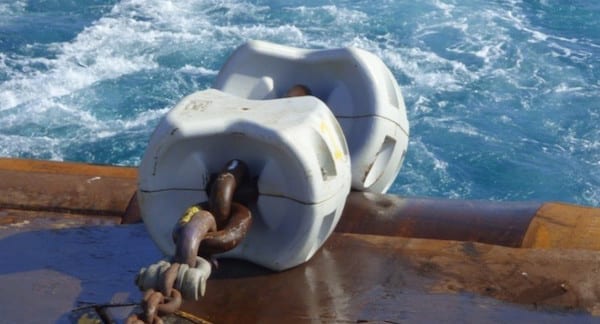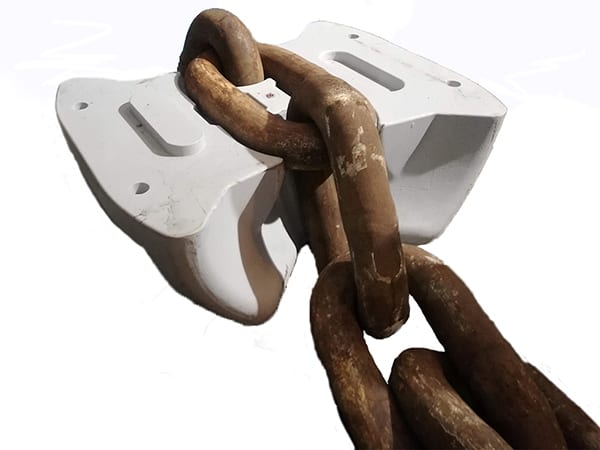Clump Weights in Offshore Mooring Systems
Offshore moorings have a long tradition in the oil and gas industry. Even though most offshore mooring systems feature similar components, they differ a lot in design, depending on the bathymetries, the metocean data, and the design of the platform they support. But despite the wide range available in the market, the fast development of the marine renewable energy (MRE) industry-and especially of the floating offshore wind sector-requires new solutions to solve new challenges and concerns. Cost reductions, shallower waters, smaller mooring areas, and limited footprints highlight the main difficulties.
Clump weights are emerging today as one of the mooring components best able to meet the requirements of the MRE sector at a reasonable cost. Ideol chose clump weights, among other solutions, to stabilize France's first floating offshore wind turbine. The Kincardine project, deployed off the coast of Scotland by Cobra with the Principle Power Platform is also featuring clump weights. Other leading companies are currently making final investment decisions while considering the solution as well. Clump weights can be easily coupled to some of the traditional mooring designs to contribute to the restoring forces applied by the mooring system on the platform.
Clump Weights: An Innovative and Reliable SolutionMade usually of cast iron EN-GJL-200 with the high density of 7.1, clump weights are especially designed to offset the vertical forces against the anchor. Thus, they restrict the movements of the floating structure by contributing to the restoring forces, without resorting to expensive solutions of longer mooring line length.
There are two available designs: distributed and mutualized. These configurations have been created out of the need for cost-efficient, safe, and reliable solutions, responding to the various needs of the mooring systems of the following three marine renewable energy technologies: floating wind turbines, wave power systems, and floating tidal stream devices.
The distributed configuration represents a set of medium-sized clump weights, distributed over a segment of the mooring line (Figure 1). This configuration optimizes the effectiveness and the cost of the solution thanks to the proportional recovery of the loads and the most accurate dimensioning.
 |
| 1. Distributed clump weight configuration for offshore mooring systems. Courtesy: FMGC |
On the contrary, the mutualized solution consists of one clump weight, attached to one specific point of the anchor line (Figure 2). This configuration neutralizes some of the impact of wind and wave, and thus limits the tensions on the anchoring line.
 |
| 2. Mutualized clump weight configuration for offshore mooring systems. Courtesy: FMGC |
Several studies were conducted on the behavior of cast iron in marine environments before it was selected as the best material for clump weights. The material provides a good balance between cost reduction, density, strength, limited environmental footprint, and corrosion resistance.
Clump Weights for Floating Wind Turbine MooringsAfter being largely deployed in the oil and gas sector, floating platforms have become important in the MRE sector as well. Because space is abundant and offshore wind resources are more consistent-guaranteeing high energy output-floating wind power is considered one of the most-promising sources of sustainable energy today. However, they require highly reliable mooring solutions, ready to withstand the loads applied by the environment.
Floating structures provide new opportunities for manufacturers and power companies by opening areas and markets that were previously unavailable for the offshore wind sector. Yet, designing a platform and a mooring for floating offshore wind turbines remains difficult, because the system must fulfill countless requirements for dynamic characteristics and loads. Wind speed and turbulence, currents, waves and tides, marine growth, and air density require a highly reliable mooring system, taking all permanent, variable, and environmental loads. Moreover, the implementation of a turbine with a 100-meter height is also a key element to which the mooring system needs to withstand. And clump weights do.
A good example is offered by the first French offshore wind turbine, kept in place with cast iron clump weights. The solution has been especially designed and manufactured by the national leader in cast iron ballast solutions-FMGC. These are the first clump weights ever used in the installation of a floating offshore wind turbine in France. The solution contributes to the optimization and cost effectiveness of the entire mooring system.
Clump Weights for Wave Power System MooringsWave energy converters (WECs) are currently a technology that is at a rather low level of development. Like all other floating structures, WECs need to be kept in position by station-keeping systems with a compliant mooring system.
WECs are usually categorized in oscillating water columns (OWCs, energy is extracted by Wells turbines), in overtopping devices (OTDs, energy is extracted by low-head Kaplan turbines), or wave-activated bodies (WABs, energy is extracted by hydraulic systems). Significant advancements achieved in these three groups could make WECs an essential part of the renewable energy mix very soon.
Because of the highly non-linear action of very high waves entering relatively shallow waters, designing the right mooring system for a wave energy converter is quite challenging. This is due to the fact that unlike conventional offshore structures, WECs are designed to develop specific motions under wave loading. A WEC is supposed to constrain unwanted motions, but at the same time also permit motions that produce power.
The major requirements for a WEC mooring don't differ a lot from the requirements for the moorings of other floating applications. Withstanding the environmental and other loadings, limiting drifting motions-even in extreme waves-to keep the system in place, and cost efficiency are the main points to consider.
Clump weights can ease the development in this case by adding additional stability and thus ensuring the performance of the system. The solution reduces the loads on the mooring lines and anchors compared to a conventional catenary mooring. Furthermore, cast iron contributes to the cost optimization of the product. The design used from Floatgen has been especially created to limit installation and maintenance costs.
Floating Tidal Stream MooringsThere is great variation in designs for floating tidal stream systems under development. Currently, the most-advanced floating tidal stream project is Orbital Marine, but no one concept has yet settled. Most designs are still at the pre-production demonstrator and the prototype testing stage. But one thing is sure, foundations and installation methodology are a key area here as well, and a highly resistant mooring would be of essential importance. Clump weights are a viable option.
Mooring systems with different line components, such as clump weights, have proven performance characteristics. Better stiffness properties and the ability to limit peak tensions in the mooring lines are two of the main clump weight advantages. The size, material, and shape of the clump weight are of crucial importance to its performance. Cast iron leads to significant weight reduction, thanks to the material's high density, without harming resistance and strength. This is a cost-efficient product, responding to the toughest requirements of the marine sector and possessing a great potential to solve many of its current challenges.
-Ralitsa Peycheva is a technical content manager at Farinia Group (www.farinia.com).
The post Clump Weights in Offshore Mooring Systems appeared first on POWER Magazine.